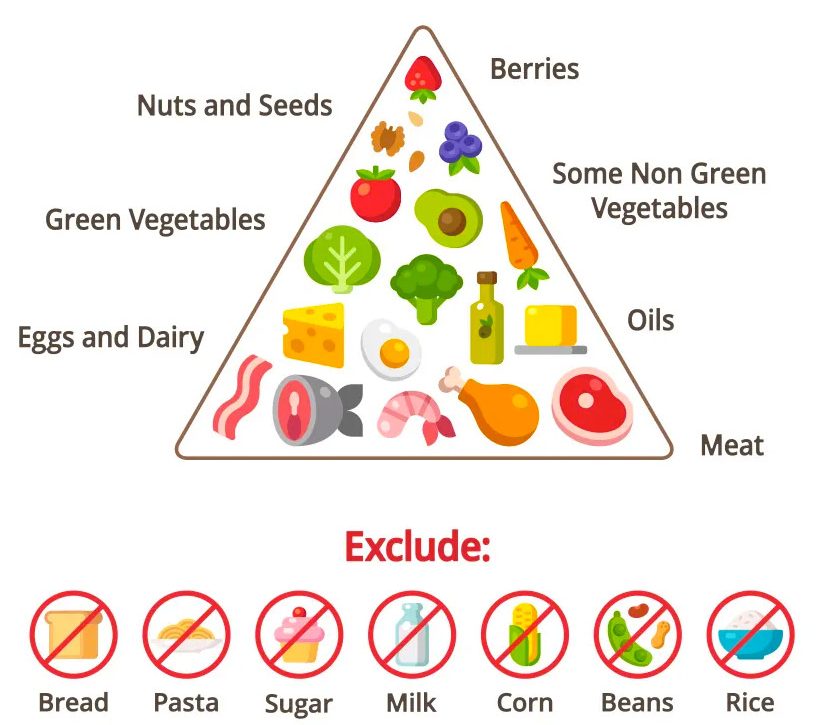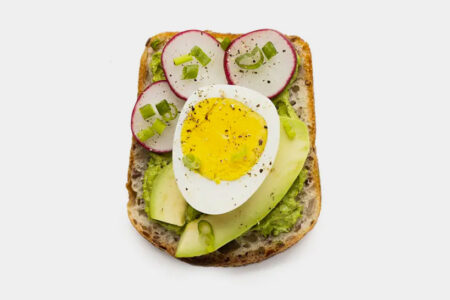A standard food pyramid is a triangular diagram representing how much of each food group you should eat daily for optimal health. The United States Department of Agriculture made its first food pyramid in 1992 based on meta-analyses. But starting 2011, MyPlate has replaced the standard Food Pyramid.
The problem with these kinds of guidelines is that they’re very flawed, confusing, and generic. Critics also claim that food lobbyists played a much too influential role in shaping the standard food pyramid as we know it 1. Still, food pyramids can be a useful tool for learning about nutrition, even if you’re on a keto diet.
To help you learn about keto nutrition, the keto food pyramid gives you a visual representation of how this diet looks like. You’ll see that this food pyramid is different from standard food pyramids with some even being turned upside down, literally.
A Look at the Keto Food Pyramid
Unlike standard food pyramids, with carbs at their base and fats at the very end, the keto food pyramid has fats at the base and carbs at the end. The keto food pyramid is based on the macro recommendations for this particular diet:
- 5% calories coming from carbs
- 25% calories coming from proteins
- 70% calories coming from fats

Macros, or macronutrients, are nutrients you need in large amounts for energy, development, and functioning. Some argue that water and fiber are also macronutrients. In contrast, micronutrients are those you need in small amounts for health and functioning. The latter include vitamins and minerals.
The 70% of calories in the form of fat should ideally come from healthy sources on a keto diet. That’s why foods like avocados, olive oil, coconuts, fish, and eggs are shown as the backbone of keto eating. So, it’s not just about macronutrient ratios – the quality of the food from which these macros come from is also vital.
More on Following the Keto Food Pyramid
You probably also noticed that the standard food pyramid lists whole grains, legumes, pasta, rice, and other carb-rich foods at the bottom. Well, the keto food pyramid completely excludes these sources of carbs and replaces them with:
- Leafy Greens
- Low-Carb Vegetables
- Nuts & Seeds
- Berries
- Low-Carb Fruit
These foods are generally low in carbs, but high in fiber. The reason it is important to stick to low-carb food choices is to:
A. help lower your carb intake so you can reach ketosis
B. still meet your minimal needs for carbohydrates as well as vitamins, minerals, and fiber.
Although carbs are reduced to a miniscule 30 grams a day on keto, that doesn’t mean these macros are not important, so you might just as well not eat them at all. Carbs are, in fact, very important — it’s just that most people are eating too much. And as already mentioned, lowering carb intake is non-negotiable if you want to reach ketosis.
What About Protein?
Many mistakenly believe that the keto diet is a high-protein diet just like Paleo or Atkins. In reality, keto is a high-fat, moderate-protein, and very low-carb diet. Moderate is defined as 25% of your daily calories consisting of protein foods. That’s around 125 grams of protein for a 2,000-calorie diet.

The reason you also need to limit protein on keto is that your body is able to turn protein into glucose when necessary. This is done via a metabolic pathway called gluconeogenesis 2. Gluconeogenesis is meant to keep your blood glucose levels high, but you don’t want that on keto.
And yet, you also don’t want to eat too little protein. Protein is essential for muscle growth, tissue repair, and the production of hormones and enzymes 3. As long as you are eating the recommended amounts of protein every day and sticking to these limits, you’ll be in ketosis and stay healthy.
And as for protein sources, the keto food pyramid shows that it’s best to opt for foods that contain high levels of both fats and protein like fatty fish, fatty cuts of meat, pork, nuts, seeds, and full-fat dairy. This way, you’ll make sure you are eating enough fat while taking in a moderate amount of protein.
Why Food Quality Matters
Looking at the keto food pyramid, you likely noticed that the foods listed are real, wholesome foods. The keto diet truly is based on eating wholesome, minimally processed ingredients. There are two reasons for this:
1. Easier to track your macros
In order to keep track of your macros, you need to know what’s in your food. That’s much harder when you’re eating pre-packaged, ready-made meals.
2. Essential for health
The ultimate goal of keto is better health. A sure way to improve health is eating wholesome foods as these contain healthful nutrients and are free of additives, preservatives, hidden carbs, pesticides, and other harmful chemicals.
Generally speaking, you should ideally go for organic, grass-fed, and Pasture-raised ingredients which you will find on the keto food pyramid. If that’s not possible, simply go for the least processed ingredients you can find. Good examples of quality foods to fill your pantry with include:
Grass-fed butter
Studies show that milk from grass-fed cows contained more omega-3 fatty acids and antioxidants than cows fed hay or grains 4, 5. Studies also show that our diets are deficient in these particular essential acids 6.
Organic vegetables
Organic food contains less pesticides and antibiotics than conventionally-grown food 7. Organic foods also have greater levels of some nutrients like vitamin C, iron, magnesium, and phosphorous 8.
Leafy greens
Leafy greens are good to eat on every diet, but especially on keto. These are low in carbs, high in fiber, and rich in vitamins, minerals, and flavonoids. Studies show that a diet rich in leafy, green vegetables protects the brain against age-related cognitive decline 9.
Healthy oils
Olive oil, coconut oil, and macadamia nut oil are all great keto options. These are at the base of the keto food pyramid because they’re 100% fat. Adding them to every meal helps you meet your daily requirements for fat. And besides that, you also boost your health, especially with MUFA-rich olive and macadamia nut oils.
Pasture-raised & free-range
Animals raised this way experience lower levels of stress, see more sunlight, and are generally healthier than conventionally farmed animals. As a result, the meat, eggs, and dairy from these animals are healthier but also tastier. Since you’ll be eating more of these foods on keto, it’s best to pick the healthiest kind.
The keto food pyramid often does not list keto staples like coconut and almond flour, almond milk, peanut butter, lard, stevia, MCT oil, or collagen peptides anywhere on the keto food pyramid. That’s because these ingredients are not necessary for the keto diet to work or for your health. They are, however, helpful, and you can see them as great additions to your basic keto plan.
Conclusion
The keto food pyramid is almost like your standard food pyramid turned upside down. At its base, you’ll find high-fat foods like olive oil, coconut, avocados, and bacon. At its end, you’ll see berries and other low-carb fruit. And in between, the keto food pyramid lists protein-rich foods and low-carb vegetables.
This arrangement is entirely based on keto macros, which are at the center of the ketogenic diet. On keto, it’s all about the macros, so you need to make sure you’re eating the right kind of food to stay within your limits. The keto food pyramid helps you with that by giving you a visual representation of the ketogenic diet.
Keep in mind though, that the keto food pyramid isn’t perfect. The keto diet is too complex to be explained in one triangular diagram. That’s why you may want to take note of keto supplements and low-carb alternatives on your keto journey.










![Juicing for Weight Loss: Everything You Need to Know [Plus Recipes]](/wp-content/uploads/2019/08/Juicing-for-Weight-featured-image.jpg)









http://essaypapers.reviews/